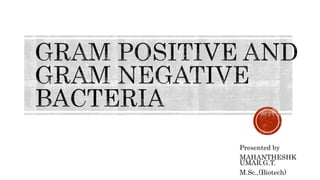
Gram positive and gram negitive bacteria
- 2. Gram staining is the use of stains to differentiate between the two major types of bacteria Is called a differential stain for that very reason Helps to understand different characteristics of bacteria Has been perfected by modification of the original experiment over the years Widely used from high school experiments to clinical microbiology laboratories
- 3. Method invented by Hans Christain Gram in 1884. Was originally devised to make bacteria more visible. He observed that some bacteria destained after he washed it with ethanol (typhus bacillus). This unstaining of certain bacteria was due to certain bacteria having thin cell walls(He called those gram negatives). The stained ones were named gram positive. His methods were revised and now we stain both gram negative and gram positives for better visual under the microscope .
- 4. Gram staining is used to differentiate between two different groups of bacteria. The classification helps to identify some of the characteristics the bacteria may have. Method was adopted and is widely used as it is cost effective, easy and the results are reliable. Method should not be used to diagnosis or for specific identification as it only distinguishes one large group to another and not specific species of bacteria.
- 6. They are gram positive cocci that occur in grape like clusters. They are ubiquitous and the most common cause of localized suppurative lesions in human beings.
- 7. 2 groups: Coagulase positive (Staphylococcus aureus) Coagulase negative staphylococci (CoNS)
- 8. Morphology: Spherical cocci Approximately 1µm in diameter Arranged in grape like clusters. This is due to cell division occurring in 3 planes; with daughter cells tending to remain close proximity. They stain readily with aniline dyes and are uniformly gram positive.
- 9. Aerobes and facultative anaerobes Opt. Temp. :37 ºC pH: 7.5 They can grow readily on ordinary media.
- 10. Nutrient agar Blood agar MacConkey agar Milk agar Phenolphthalein phosphate agar Selective salt media
- 12. Staphylococcus aureus and the other micro coccaceae are among the hardiest of the non-sporing bacteria. They have been isolated from dried pus after 2-3 months. It withstands moist heat at 60 ºC for 30 min but is killed after 60 min.
- 13. Cytolytic toxins Enterotoxins Toxic shock syndrome toxin-I (TSST-I) Epidermolytic toxins (Exfoliative toxins)
- 14. Coagulase Coagulase test Slide coagulase test Tube coagulase test
- 15. Cutaneous infections Deep infections Toxin mediated diseases • Food poisoning • Toxic shock syndrome (TSS) • Exfoliate diseases
- 16. Specimens Direct microscopy Culture Identification Antibiotic sensitivity tests Bacteriophage typing Serological tests
- 17. Benzyl penicillin Patients allergic to penicillins may be given erythromycin, vancomycin, first generation cephalosporins. For cutaneous infections, oral therapy with a semisynthetic penicillin such as cloxacillin or dicloxacillin is usually efficacious. For mild superficial lesions, application of drugs as bacitracin, chlorhexidine or mupirocin may be sufficient.
- 18. Sitch abscesses; endocarditid bacteremia Osteomyelitis Wound Infections Prosthetic Joint infections
- 20. Streptococcusis a genus of Gram-positive coccus (plural cocci) or spherical bacteria that belongs to the family Streptococcaceae, within the order Lactobacillales (lactic acid bacteria), in the phylum Firmicutes The genus streptococcus comprises of gram-positive cocci that grow in pairs of chains They are normal flora of humans and animals
- 23. Biochemical and other criteria are also used in defining various species within a single serogroup, and some species contain strains of more than one serogroup. 1.Morphology 2.Cultural Characteristics 3.Biochemical Reaction 4.Antigenic Structure 5.Toxins and Enzymes 6.Pathogenesis 7.Diseases 8. Diagnosis
- 24. Streptococcus pyogenes are gram-positive, spherical to ovoid organisms 0.5-1.0 mm in diameter The organism grows in short or moderately long chains. Chain formation is due to the cocci dividing in one plane only and the daughter cells failing to separate completely.
- 25. They are aerobes and facultative anaerobes, growing best at temperature of 370 C. The optimal pH growth is 7.4-7.6 The exacting in nutritive requirements, growth accuring only in media containing fermentable carbohydrates or enriched with Blood or Serum Media
- 26. S. pyogenes is Catalase negative. Insoluble in 10% bile unlike S. pneumonia. It ferments several sugars producing acid and no gas. Hydrolysis of pyrrolidinyl naphthylamine(PYR test) is positive.
- 27. 1.Capsule. 2.Group-specific polysaccharide antigen. 3.Type specific antigen.
- 28. 1.Hemolysins 2.Pyrogenic exotoxins 3.DNA (Streptodornase) 4.Streptokinase 5.Hyaluronidase 6.Proteinase 7.Other enzymes
- 29. Acute diseases associated with S. pyogenes occur chiefly in the respiratory tract, bloodstreams, or the skin. Two post streptococcal sequelae, occur in 1- 3% of untreated infections
- 30. 1.Respiratory infections I. A. Sore throat infection II. B. Suppurative infections 2.Skin and Soft Tissue Infections 3.Other Suppurative Infection I. A. Puerperal sepsis II. B. Non-suppurative Sequelae
